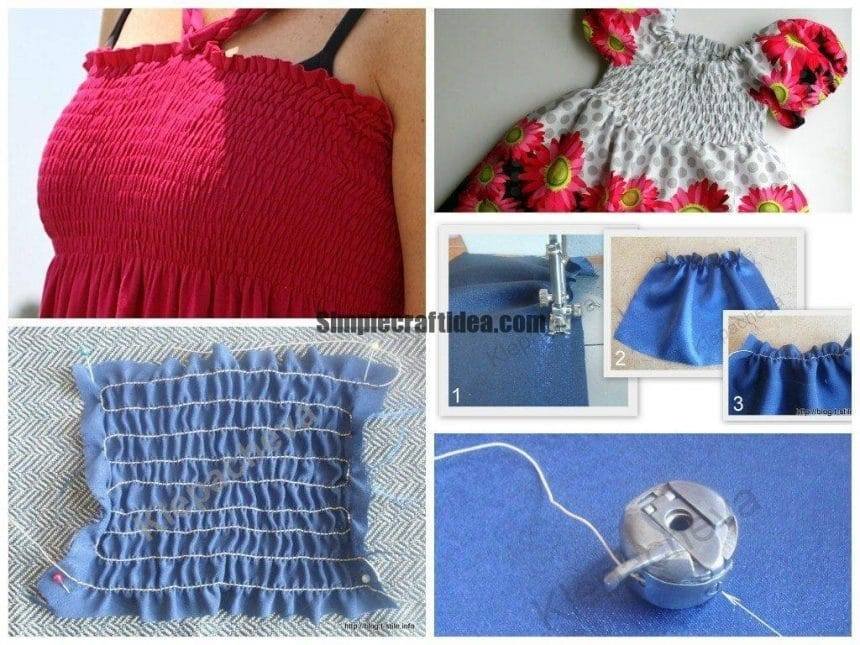How to sew elastic thread

This article will talk about the special sewing elastic thread, which is the core of the rubber ribs, braided textile yarns. This thread is called in common parlance or rubber thread.

It is important to know that is also used for sewing a rubber streak without braiding technology to work with it a little different, and in this article will not be considered.
Rubber thread produces uniform elastic, ie stretching assembly that allow the product fit snugly to the body, but did not limit the freedom of movement, allowing the body free “live” and “breathe”. Flexible assembly used on the edge of the neck, the bottom of the sleeves, the waist line or even the whole piece, for example, bodice sundress.


Once again, today we will talk about sewing a rubber thread , ie, the use of rubber thread as a thread in a sewing machine refueled. The fact that a rubber thread can be used not just tucking into the machine, but also by enclosing the line, this option here today will not be considered.
The entry is completed, go to the sewing technology.
Bobbin thread
For flexible assembly of rubber thread is used as bobbin thread onto the bobbin and is wound .
Drum can be either manually or automatically. Especially when winding stretch the string do not need it anyway rewound with some tension, with automatic winding is stretching may be more.
But it does not matter, because the main thread tension rubber will take place during the filing of the bobbin case. Now that’s important! It is necessary to adjust the tension of the lower thread. The adjustment is made by loosening screw

The thread of the bobbin case should be not weak and not tight, but with some effort. Unfortunately, it is difficult to describe in words :).
Try to pull the string, it must first be stretched, and then wound at a bobbin.
Loosening or tightening the screw can achieve different yarn tension, and thus varying degrees sosbarivaniya
Go on.
Threading the upper thread
As the upper thread used common thread, preferably solid, ie not c / b, and reinforced ( more about threads ), as line during the operation of the product will always be experiencing severe stress.
The tension of the upper thread should be loosened to weave the thread going on the underside of the material. The stitch length set the maximum.
The test sample
It is mandatory to carry out a test sample lines on scraps of fabric.
Perform line on the front side of the fabric, stitch as usual, the line will be formed itself by stretching the rubber thread from the spool

We assess the quality of stitching and assembly (Figure 2 – on the front side, Figure 3, from the wrong side).
If necessary, adjust the stitch length and thread tension.
After the first line you may have the feeling that the line “rather weak”. It is, therefore, to produce a stable assembly is not one, but at least 2-3 parallel lines.
If you decide to use a flexible assembly on a large plot of products, for example, on the bodice dress, you need to define the aspect ratio.
For this it is necessary to prepare a rectangular piece of cloth of a certain size, for example 25 × 15 cm. Chart on the front side of the fabric stitch line.
Run the first line (1), before reaching the end parts turn 90? (2), to go down to the next line marking, again turn 90? and perform a 2 line (Figure 3). It should stretch the fabric hand to the fabric under the presser foot supplied without assembly.

The result will be like this

Our task now is to determine how much tissue has shrunk.

If the tissue sample was 25 cm wide, the site for assembly width 23 cm. After the plot lines with assemblies get the width of 11.5 cm.
Coefficient assembly 23 / 11.5 = 2.
Consequently, for this fabric with these stitch adjustment is required with these threads in the fabric 2 times greater than the width of the part as a finished product.
For the other fabric is another factor. Each time you need to calculate your odds.
And a few more comments on the completion of the theme.
At the beginning of the lines do not tack, leaving tails thread longer, stretch the top thread to the wrong side of the material, contact with the rubber, and additional anchoring stitches by hand, so as not slipped (the main problem of the market of things)
Rubber thread is available in all colors and is chosen according to the color poshivaemoy tissue. I have to prepare for the post of illustrations used thread of contrasting color for greater visibility.
The lines-assembly is best done on a separate piece and then collect the product together.
If your future dress (blouse) is a rectangular piece of cloth, which -sborki lines will be performed at the site of the bodice, the only seam of the dress is not desirable to locate the rear and side.
Elastic stitch in a row can be used in the manufacture of ordinary frills as auxiliary lines: paved stretch stitching on the edge stitched ruffles, Stitch frill, remove the elastic line.






And I repeat. Coefficient of assembly depends on the type of fabric, thread type, the tension of the thread, stitch length, so in advance to say “how much fabric you need,” no way.






